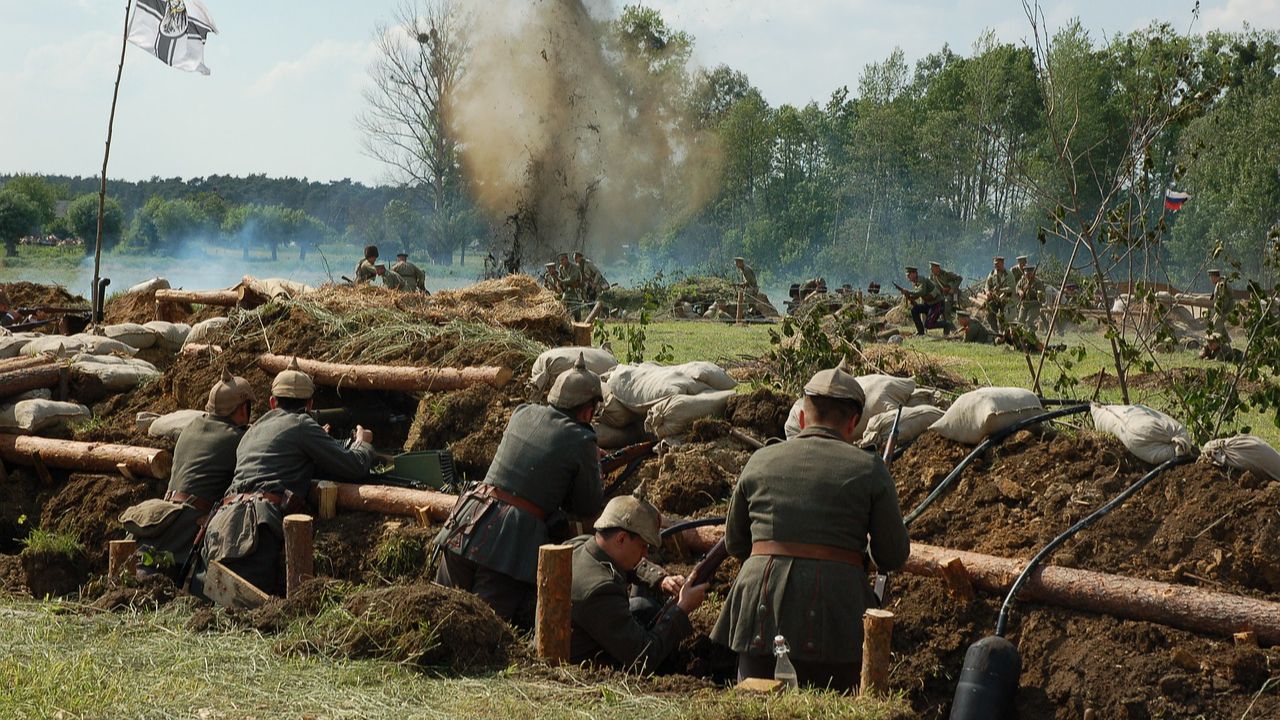Teaching the Causes of World War One (WW1) Worksheet!

The main causes of the first world war (WWI) are often misconstrued, especially for younger students!
Well-designed worksheets that incorporate the influences of various European countries, such as the Austro-Hungarian Empire, as well as the Ottoman Empire, and the influence of the Triple Alliance and the assassination of Franz Ferdinand in the origins of World War I can help students better understand this important time period!
Screenshot of one of the WW1 worksheets included with my 5th Grade Social Studies YEAR-LONG Curriculum Bundle:
High-Level Overview on the Causes of WWI
The First World War, also known as World War I, broke out on July 28, 1914, and lasted until November 11, 1918. By the end of the war, over 15 million people, primarily from the various European powers, had lost their lives due to the war itself. World War I had been called the Great War, the World War, and the War to End all Wars before the outbreak of World War II in 1939.
Virtually every major power in the world, including ALL of the great powers of Europe, was involved in the devastating military conflict. There were two groups working against one another: the Allies and the Central Powers.
Some of the most prominent members of the Allied coalition included: the British Empire, Russian Empire, France, the United States, Italy, Greece, and Japan
Prior to the outbreak of WWI, in 1907, a military alliance between Great Britain, France, and Russia, known as the Triple Entente (a progression of the alliance that had developed out of the Franco-Russian alliance about a decade earlier during the mid-1890s), was formed.
Some of the most prominent members of the Central Powers included: Austria-Hungary, Germany, and Turkey
Download a FREE WEEK of lesson plans HERE!
Schlieffen Plan
As tensions mounted throughout Europe during the early 1900s, a man named Graf von Schlieffen proposed what would become known as the Schlieffen Plan. Schlieffen was an avid student of both European history and military history and his plan was designed to allow the German Empire to wage war on two fronts. Schlieffen proposed his plan in 1905 when he was serving as chief of the German general staff, nearly a decade before WWI broke out and would later be replaced in that role by another man, Helmuth von Moltke. Moltke would implement significant modifications to the Schlieffen Plan which would later be blamed for Germany's failure to achieve a speedy victory in the war.
Information for Young Students (5th -7th grade) Regarding World War One
One single historic event sparked the violence that would culminate in the outbreak of WW1: the assassination of Archduke Franz Ferdinand of Austria and his pregnant wife Sophie on 28 June 1914
Emperor Franz Josef's nephew and rightful heir to the thrones of Austria and Hungary was Archduke Franz Ferdinand. The assassination was planned by "The Black Herd", a Serbian terrorist group and was carried out by a Bosnian revolutionary named Gavrilo Princip.
While that one single event sparked the fighting, it wasn't actually one of the many main causes of World War I. If you're like me, it may help you and your students to think of the assassination of Archduke Franz Ferdinand as the burning match thrown on to a dry pile of leaves, twigs, and branches, that ignited the fire (the fire being WWI!).
Some of the ACTUAL main causes of World War One include:
- Disputes over international strategy and disagreements amongst some of the world's major powers on foreign policy
- A complex web of alliances amongst European powers (including some secret alliances!)
- A regional history wrought with recent military conflicts and burning desires for retribution and revenge (for example, Austria-Hungary annexing Bosnia which angered and antagonized Serbia)
- A desire for some European powers to keep the balance of power intact and/or to expand their borders and reclaim territory lost in earlier conflicts
- A rise in military technology and production
Check out my history curriculum bundles HERE!
World War One was also widely known as "The War to End All Wars," "The War of the Nations," "WW1," and "The Great War" are all alternative names for World War One!
United States entry into WWI
As a result of the deaths of 128 Americans at the hands of a German submarine, the United States entered World War 1. The Lusitania, a British passenger liner, was sunk by a German submarine in 1915. Overall, 1,195 people perished, including 128 Americans. Outraged citizens demanded that the U.S. government intervene in the conflict.
In 1917, when the Germans declared that their submarines would sink any ship that approached Britain, President Woodrow Wilson declared that the United States would enter the war to restore peace in Europe. On April 6, 1917, America officially joined the war.
Just seven and a half months of U.S. time were spent in active combat. Over 116,000 Americans were killed and another 204,000 were injured during the United States' brief 7.5-month involvement in active combat.
World War One draws to a close
As early as 1918, Germans were protesting the war through strikes and demonstrations. Thousands of Germans were starving to death, and the country's economy was collapsing because the British navy had blocked access to German ports. Allied and Central Powers leaders met in Compiegne, France, on November 9 after the abdication of German Emperor Kaiser Wilhelm II. On November 11th, a peace armistice was signed. Four major empires, including the Russian, Ottoman, German, and Austro-Hungarian ones, had fallen by the war's end.
Signed in 1919, the Treaty of Versailles officially ended World War I. Germany was required to pay reparations to Allies, acknowledge its role in starting the war, cede territory to its neighbors, reduce its military strength under the terms of the Treaty, and surrender their African colonies.
As part of its mission to forestall further hostilities, the treaty also created the League of Nations. Fifty-three countries had joined the League of Nations by 1923, and it had greatly aided in Europe's recovery. However, the United States Senate rejected membership in the League of Nations, causing its founder and President Wilson significant mental anguish and contributing to the need for him to spend the rest of his term in a wheelchair.
In 1926, Germany became a member of the League of Nations, despite widespread animosity toward the Treaty of Versailles. In 1933, both Germany and Japan left the League of Nations. After three years, Italy withdrew. Germany, Italy, and Japan were all able to expand their power and conquer neighboring countries despite the League of Nations' best efforts to prevent them. Many people think the First World War never ended and that WWII would not have happened without it.
WWI Interesting Facts
- There were a total of 65 million soldiers involved in the war, with 8 million killed and 21 million injured
- On the first day of the Battle of the Somme, the British army lost 58,000 men
- The first use of chemical weapons dates back to WWI - mustard gas was the substance that caused the damage
- While much of World War One was fought in muddy trenches, a small but dedicated group of miners would also tunnel under the enemy's lines and set off mines
- Over 900,000 pounds of explosives were simultaneously detonated by these miners in Messines Ridge in Belgium, completely obliterating the German front line
- The British Prime Minister, David Lloyd George, who was in Downing Street 140 miles away, heard the explosion because of its intensity and volume
- During the war, the government restricted the movement of journalists and attempted to stifle any news coming from the front
- Each week, the front received 12 million letters, a significant portion of which were written and sent by the soldiers loved ones back home
- Over two billion letters and 114 million packages were sent to the front lines by the time the war ended
- World War One spurred the development of plastic surgery
- A surgeon named Harold Gillies helped soldiers who had been severely injured by shrapnel to their faces; Dr. Gillies developed the earliest methods for facial reconstruction
- Many soldiers suffered facial wounds from shrapnel during World War I, and these injuries were much more severe than those caused by bullets because of the twisted metal
- As a result of need during World War I, blood banks came into existence
- Blood transfusions became standard practice during World War 1 in order to treat wounded soldiers
- A medical officer in the United States Army, set up the first blood bank on the Western Front in 1917
- During World War One, the youngest British soldier was just 12 years old
- More than 250,000 people during WWI who were too young to serve did so anyway
- Many thousands of boys under the age of 18 enlisted, and the vast majority of them lied about their age
- Some of the boys joined out of patriotism, while others hoped to leave their disadvantaged hometowns behind them
- Nine out of ten British troops made it through the trenches alive
- This is because they were constantly on the move throughout the trench network and thus largely shielded from enemy fire
- For the vast majority of British soldiers, life during World War I was actually rather dull and routine
World War I Worksheets
From its historical context and root causes to the harsh realities faced by soldiers in the front lines worksheets that provide engaging exercises that will test students' knowledge and skills are a GREAT way to help your students comprehend and understand the many complexities and nuance of World War 1 (especially when it comes to what actually caused the war!).
World War I worksheets should be tailored to the individual student's level of familiarity with the subject matter
Another WWI worksheet included with my 5th Grade Social Studies Curriculum Bundle!
Well-curated worksheets on WWI will:
- Bring attention and awareness to the harsh and often brutal conditions under which people fought and lived during WWI (in particular, in war-ravaged places throughout Europe)
- Stimulate your students analytical abilities and critical thinking skills
- Inspire introspective thinking of the more nuanced circumstances under which the events of WWI they have studied unfolded
- Appropriately and easily assess student learning and comprehension!
Imagine...
-
Spending more time on teaching and less on lesson plans
-
More time on nights and weekends to share with friends and loved ones
-
No longer endlessly searching for amazing lesson plans and resources
Click HERE to learn more about my amazing history curriculum bundles!
I *think* you'll be happy you did 😉
I hope you enjoyed this article!
-Jillian (a.k.a. the "Lesson Plan Guru")
Receive a FREE Week of Lesson Plans!
Join my mailing list to receive exclusive offers and promotions, the latest tips, and news on product updates!
Don't worry, your information will NEVER be shared.
I hate SPAM too and will NEVER sell it to a third-party. EVER










